UN DESA | DPAD | Development Policy Analysis Division
World Economic and Social Survey
All issues since 1948
The World Economic and Social Survey (WESS) was first issued in 1994, evolving in response to a 1947 mandate by the General Assembly which requested the Secretary-General to submit annual reports on current world economic conditions and trends to the Economic and Social Council. Its precursors were Economic Report: Salient Features of the World Economic Situation from 1945 to 1947; World Economic Report (1948-1954); and World Economic Survey (1955-1993).
2014-2015
World Economic and Social Survey 2014/2015:
Learning from National Policies Supporting MDG Implementation

ISBN 978-92-1-109171-7
Sales No. E.15.II.C.1
The launching of the Millennium Development Goals (MDGs) in the year 2000 ushered in one of the most important initiatives undertaken by the global community. Concerted efforts at the international, regional, national and subnational levels to achieve the MDGs have brought about significant development progress over the past 15 years. Nevertheless, important development gaps remain.
The year 2015 was one of global action on the unfinished business of the MDGs and the many other challenges facing humankind. United Nations Member States took the leading role in promoting development for all and, through an inclusive consultation process, formulated the 2030 Agenda for Sustainable Development, launched in September along with a set of Sustainable Development Goals (SDGs). These new goals will apply universally to all countries, while taking into account different national realities, capacities and levels of development.
As the MDG experience shows, setting ambitious goals is the first step; achieving them requires concrete actions. The World Economic and Social Survey 2014/2015 reviews economic, social and environmental policies implemented at the national level and the institutional aspects that enabled them, bringing about significant progress towards achieving the MDGs. The Survey concludes with a set of useful policy lessons that Member States will find helpful in formulating strategies and policies for implementation of the 2030 Agenda, including the SDGs.
2013
Sustainable Development Challenges
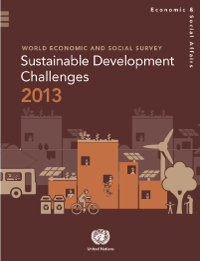
The World Economic and Social Survey 2013 contributes to the deliberations on addressing sustainable development challenges with a focus on three important cross-sectoral issues identified for action and follow-up at the 2012 United Nations Conference on Sustainable Development: sustainable cities, food security and energy transformation. Sustainable development strategies need to be inclusive and take special care of the needs of the poorest and most vulnerable. Strategies need to be ambitious, action-oriented and collaborative. They will need to change consumption and production patterns systemically, which might entail, inter alia, significant price corrections; encourage the preservation of natural endowments; reduce inequality; and strengthen economic governance.
2012
In Search of New Development Finance

Difficulties in raising sufficient domestic and external resources to finance the internationally agreed development goals, including the Millennium Development Goals (MDGs), along with the numerous drawbacks of traditional aid, are leading the quest for innovative sources of development finance. The World Economic and Social Survey 2012 analyses current and proposed mechanisms for innovative development finance and highlights mechanisms that can 1) increase the scale of development financing available and 2) provide stable and predictable financing to enhance sustainable development. The Survey confirms the potential of innovative development financing to mobilize substantial resources for international priorities, but concludes that realizing this potential requires strong political will to follow through on available proposals as well as transparency in the allocation and management of those resources.
2011
The Great Green Technological Transformation
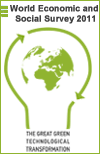
To meet both the global development objectives of conquering poverty and protecting the environment, the World Economic and Social Survey 2011 calls for a complete transformation of technology on which human economic activity is based. The Survey details new policy directions and major investments in developing and scaling up clean energy technologies, sustainable farming and forestry techniques, climate-proofing of infrastructure and reducing non-biodegradable waste production. This "great green technological transformation" is needed to renew Earth's capacity to sustain human life and permit developing countries to realize their aspirations towards growth and poverty reduction.
2010
World Economic and Social Survey 2010—Retooling Global Development
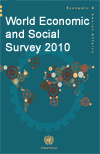
The World Economic and Social Survey 2010 highlights the systemic weakness unmasked by the recent global crises and proposes reforms in international arrangements to eliminate these deficiencies and gaps in global governance mechanisms. These weaknesses have unduly constricted national policy space and sustain the proliferation of conflicting international rules. The proposed reforms are aimed at ensuring consistency among national development efforts and global mechanisms in aid, trade and finance to pave the way towards more balanced and sustainable development.
- Buy hard copy at UN Publications
- Available from: iBookstore
- Kindle
- Nook
2009
World Economic and Social Survey 2009—Promoting Development, Saving the Planet
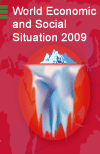
The World Economic and Social Survey 2009 argues that mitigation and adaptation efforts can better move forward as part of a development strategy built around a massive investment-led transformation, along low-carbon, high-growth paths. This transformation would keep temperature increases consistent with environmental stability, while fostering the strong growth and economic diversification necessary to allow convergence of incomes worldwide.
The Survey contends that a critical role must be played by developmental States, able to mobilize public finance and build appropriate technological capacity. A variety of market and non-market institutional mechanisms would also be needed. This potentially win-win strategy would require the readiness of the international community to step up to the plate with multilateral financing on a much larger scale than has been forthcoming to date and new approaches to transferring technology from rich to poor countries.
2008
World Economic and Social Survey 2008—Overcoming Economic Insecurity
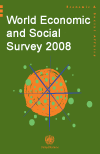
The World Economic and Social Survey 2008 offers a different perspective on economic insecurity—one that utilizes more proactive and coherent policy responses, at both national and international levels, to help communities better manage economic risks, cope with economic insecurity and secure their livelihoods.
WESS 2008 also assesses insecurity posed by weather, natural disasters and climate change; and the inherent insecurity of seeking livelihoods in countries riven by civil wars that on historical trend are becoming longer and more disruptive.
2007
World Economic and Social Survey 2007—Development in an Ageing World
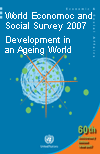
The World Economic and Social Survey 2007 analyses the implications of ageing for social and economic development around the world. The ageing of the population offers both challenges and opportunities. Among the most pressing issues is the prospect of a smaller labour force having to support and increasingly larger older population. Paralleling increased longevity, changes in intergenerational relationships may affect the provision of care and income security for older persons particularly in developing countries where family transfers play a major role. Thus, societies must also ensure seeing to the particular needs of older populations in terms of the requisite health care and appropriate living conditions. At the same time, it is also necessary to fully recognize and better harness the productive and social contributions older persons can bring to societies but in many instances are prevented from doing so.
The Survey argues that these challenges are not insurmountable, but societies everywhere need to put in place the required policies to confront these challenges effectively and to ensure adequate standard of living for all while respecting and promoting the contribution and participation that all can bring to society.
2006
World Economic and Social Survey 2006—Diverging Growth and Development
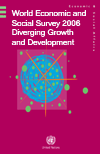
According to the World Economic and Social Survey 2006 in the industrialized world, the income level over the last five decades has grown steadily while it has failed to do so in many developing countries, thereby causing a rise in already high world inequality.
Greater income divergence is partly explained by a rising number of growth collapses. Countries with weak economic structures and institutions and low infrastructural and human development have less capacity to gain from global markets
2005
World Economic and Social Survey 2005—Financing for Development
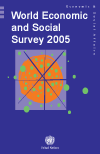
The World Economic and Social Survey 2005 focuses on the Monterrey Consensus as the current framework for international cooperation for development. The report examines the correspondingly broad agenda for action that was set out in the Consensus, recognizing numerous accomplishments to date and draws attention to the further actions in the financing and trade areas that need to be undertaken in the years ahead to achieve both the Millennium Development Goals, as well as the broader United Nations Development Agenda.
2004
World Economic and Social Survey 2004
Part one: Trends and Policies in the World Economy
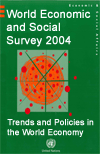
The first part of the World Economic and Social Survey 2004 discusses the state of the world economy in 2004 and the outlook for 2005. It includes a review of developments in international trade and finance and an overview of the situation in the world's economies as of mid-2004 and their prospects for 2005.
Part two: International Migration
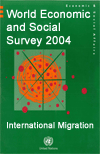
The second part of the World Economic and Social Survey 2004 addresses international migration. It examines historical and recent surges in migration, policies towards migration, its economic and social effects, the question of refugees and the state of international cooperation regarding migration.
2003
World Economic and Social Survey 2003—Trends and Policies in the World Economy
Part one: State of the World Economy

Part one of World Economic and Social Survey 2003 discusses the state of the world economy in 2003 and the outlook for 2004. It includes a review of developments in international trade and finance and an overview of the situation in the world's economies as of mid-2003 and their prospects for 2004.
Part two: Economic Policy and Poverty
The goal of reducing poverty by half by the year 2015 has prompted policymakers to increase the attention given to policies and measures directly targeted at achieving this goal. At the same time, it is also necessary to examine policies and measures related to other goals that are expected to have a bearing on, but are not specifically directed at, poverty reduction. Part two of World Economic and Social Survey 2003 examines a number of areas in which policies are expected to have a beneficial effect on poverty over the medium or longer term, even if poverty reduction is not their primary short-term goal. These include monetary and fiscal policies (chap. V), trade policies (chap. VI), agricultural reforms (chap. VII) and policies arising from the move from a planned to a market economy (chap. VIII).
- Download report:
- Table of Contents,
- Chapter I,
- Part II
2002
World Economic and Social Survey 2002—Trends and Policies in the World Economy
Part one: State of the World Economy
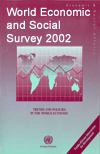
In the second half of 2002, the world economy stands at a delicate juncture. After the weakest performance in a decade for the year as a whole, global economic recovery is under way. However, neither the strength, nor the breadth, nor the durability of the recovery is assured.Part one of World Economic and Social Survey 2002 investigates the causes of the pervasive slowdown in 2001, as well as the driving forces behind and threats to the recovery.
Part two: Private-Public Interaction in Achieving Society’s Goals
Part two of World Economic and Social Survey 2002 examines selected aspects of the changing nature of the interaction between the public and private sectors in producing some of the goods and services that societies as a whole may desire as part of their overall development. In all countries, the State has a number of essential tasks, such as providing external defence, maintaining domestic law and order, ensuring the rights of future generations (for example, with respect to the environment), pursuing agreed redistributional goals (notably addressing poverty) and addressing market failures. Previously, there was widespread belief that the State itself should produce or provide directly a number of goods and services that contributed to these or other goals. However, it is increasingly recognized that, in many different ways, the involvement of the private sector in such production and distribution can result in these goods and services' being provided more efficiently and effectively than if the public sector operates alone.
2001
World Economic and Social Survey 2001—Trends and Policies in the World Economy
Part one: State of the World Economy

Part one of World Economic and Social Survey 2001 chronicles how the very positive developments in output and international trade, with reasonably buoyant levels of international finance for emerging markets for the first half of 2000, turned into retrenchment. The ongoing downturn in the business cycle in developed countries has been unusual in a number of respects when contrasted with previous downturns in the post-war period.
Part two: A Globalizing World: Risks, Vulnerability and Opportunity
Part two of World Economic and Social Survey 2001 looks at some examples of vulnerability in the context of globalization, with the discussions focusing on how the liberalization of financial markets can bring benefits to individual countries, but only after a proper regulatory framework has been put in place; how trade shocks can be absorbed and whether the risk of such shocks reduces the potential gains from trade; how three small landlocked transition economies survived the shocks arising from the collapse of the centrally planned system; and how a country can cope with a recurrent and, to some extent predictable, natural disaster—flooding. The insights from these chapters should help the international community as it confronts the issues of vulnerability and globalization.
2000
World Economic and Social Survey 2000—Trends and Policies in the World Economy
Part one: State of the World Economy
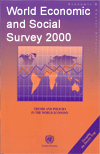
Part one of World Economic and Social Survey 2000 chronicles a remarkable recovery in the world economy after the crisis years 1997-1999. Although the volume of international financial flows has not returned to its pre-crisis level, international financial markets are again displaying a sense of calm. International trade has also largely recovered from the setback it suffered following the financial crises.
Part two: Escaping the Poverty Trap
Part two of World Economic and Social Survey 2000 identifies a number of Part two of World Economic and Social Survey 2000 identifies a number of critical steps for the poorer countries to break out of their "poverty trap" and find a path to sustained and sustainable development—a path that has proved so elusive to so many countries for so long. Some of these, such as the need to achieve progress in agriculture, used to have a key role in development policies but have suffered relative neglect over the years. Others, such as the roles of education and technology, have always been in the agenda but the results have been mixed and many lessons have been learned. Yet other dimensions, such as the role of institutions, have come to the forefront only recently. The objective of part two is to identify some of the actions that countries can take to start a period of rapid and sustained growth that would allow living standards to increase appreciably over a relatively short period of time.
1999
World Economic and Social Survey 1999—Trends and Policies in the World Economy
Part one: State of the World Economy

Part one of World Economic and Social Survey 1999 provides a chronicle of how large parts of the world economy were sent reeling in the past two years by the fragility of financial systems and their international connectedness. On the whole, the world economy seems to have hit bottom and most of the affected countries are moving towards recovery.
Part two: Financial Development in the Globalizing World
Part two of World Economic and Social Survey 1999 serves as a contribution to the international discussion on "financing for development". It seeks to give a perspective on the major changes that have been taking place in recent decades in the banking and financial systems of developed, developing and transition economies.
1998
World Economic and Social Survey 1998—Trends and Policies in the World Economy

World Economic and Social Survey 1998 reviews the turbulence in the world economy over the past year and offers some recommendations on ways and means to address the volatility of global financial flows. It is hoped that this analysis will contribute to the critical debate on confronting the challenges posed by globalization so that the world economy can put present difficulties behind it and resume the more favourable path of earlier years.
1997
World Economic and Social Survey 1997—Trends and Policies in the World Economy
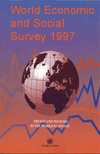
World Economic and Social Survey 1997, in addition to providing an overview of current and emerging economic trends, examines the process of fiscal consolidation around the world. Whereas most analyses of this subject have been undertaken from a purely economic point of view, the Survey seeks to underline the role of political considerations in successful fiscal reforms.
1996
World Economic and Social Survey 1996—Trends and Policies in the World Economy
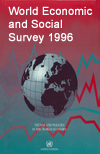
World Economic and Social Survey 1996 sees increasing grounds for optimism in the global economy, although considerable problems remain. The Survey was issued shortly after the success of the United Nations Conference on Human Settlements (Habitat II) and agreement on the need for a new global urban agenda. In addition to reviewing data and projections on the extent of urbanization, it examines trends in the provision of electric power in developing countries and alternative institutional arrangements for meeting the world's growing demand for water. Both questions are central to the implementation of the Global Plan of Action adopted in Istanbul.
1995
World Economic and Social Survey 1995—Current Trends and Policies in the World Economy
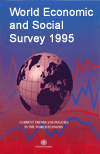
World Economic and Social Survey 1995 points to two economic and social realities existing side by side. At a time when the global economy is comparatively healthy, many regions are enjoying increasing prosperity and show an ability to sustain their growth. Simultaneously, for many of the world's citizens, this is an era of hardship—and worse suffering seems to lie ahead. In a world that is tightly linked economically, this imbalance threatens the long-term welfare of both developed and developing economies.
1994
World Economic and Social Survey 1994—Current Trends and Policies in the World Economy

World Economic and Social Survey 1994 is being released for the first time under this title, signalling the intention to integrate more fully the treatment of the economic and social dimensions of development. In addition to the usual overview of current and emerging economic trends, the 1994 Survey focuses on the issue of unemployment, which has become one of the major economic and social challenges faced primarily by developed market economies but also by countries on a global level. It also addresses demographic changes and their social, economic and environmental consequences.
1993
World Economic Survey 1993—Current Trends and Policies in the World Economy

World Economic Survey 1993 highlights the persistent weakness in the developed market economies and a further steep fall in output and living standards in the economies in transition as the dominant features of the world economy in 1992. Despite strong growth in a number of developing countries, accounting for half of the world's population, there was negligible growth in the world economy overall. In 1993, for the third year in a row, the growth of world output will fall below world population growth.
1992
World Economic Survey 1992—Current Trends and Policies in the World Economy

World Economic Survey 1992 examines the effects of the historically and politically important events that took place in the world economy in 1991. Beyond these, the global economic landscape was marked by inaction and disappointments. The developed market economies slumped, but caution prevailed and no decisive steps were taken to stimulate growth. The developing countries maintained the modest rate of economic growth seen in recent years.
1991
World Economic Survey 1991—Current Trends and Policies in the World Economy
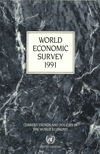
World Economic Survey 1991 examines the historical, political and economic developments that made 1990 an extraordinary year of shocks and contrasts for the world economy. These developments resulted in the slowest rate of growth of world output since 1982. Per capita income declined in large parts of the world. The forecast for 1991 is zero growth overall, with large-scale declines in the output of Eastern Europe and the Soviet Union and recession already visible in the developed market economies.
1990
World Economic Survey 1990—Current Trends and Policies in the World Economy
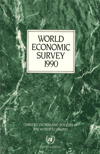
World Economic Survey 1990 analyses the effects of the great political and economic changes in 1989. It provides an overview of the major issues, a review of the changes that have taken place in the international economy in the 1980s, and an agenda for national and international action. The Survey also contains an assessment of the causes and consequences of desertification in developing countries. A special section is dedicated to the socio-economic attainment of women in recent years.
1989
World Economic Survey 1989—Current Trends and Policies in the World Economy
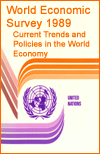
According to World Economic Survey 1989, global economic growth in 1988 confounded expectations. Not only was the expansion of world output larger than expected, but international trade and investments grew vigorously. However, this expansion failed to spread to many developing countries, particularly those in Africa and Latin America, which continued to stagnate or to grow very slowly. Three special issues are discussed in the final portion of the Survey: the socio-economic attainment of women; the early identification, analysis and monitoring of world economic developments; and selected demographic indicators.
1988
World EconomicSurvey 1988—Current Trends and Policies in the World Economy
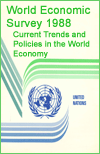
World Economic Survey 1988 highlights the dramatic financial shocks and instability in primary commodity markets, including oil, in 1987, which seem to have had only minor repercussions on the growth of output. The Survey includes a comprehensive analysis of the effects of the indebtedness and persistent fiscal and external imbalances of developed countries on the global environment and, in particular, on the development process of developing countries.
1987
World Economic Survey 1987—Current Trends and Policies in the World Economy
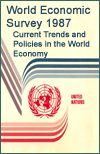
According to World Economic Survey 1987, the modest expansion that characterized the world economy during most of the first half of the 1980s persisted in 1986. Inflation has decelerated considerably and industrial countries are entering their fifth year of expansion, though at a slow pace. Indeed, the world economy appears to be set in a slow growth path, which is likely to delay the great adjustments required at the national and international levels.
1986
World Economic Survey 1996—Current Trends and Policies in the World Economy
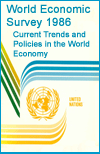
In addition to the discussion of current trends and policies in the world economy, World Economic Survey 1986 contains three special chapters (V, VI and VII): chapter V covers the increasingly clear interactions between systemic issues in trade, money and finance; chapter VI covers the effects of adjustment policies on capital formation in developing countries, centrally planned economies and some major developed market economies; and chapter VII covers the major development challenge posed by the economic crisis in sub-Saharan Africa.
Supplement to World Economic Survey 1985–1986
The Supplement to World Economic Survey 1985-1986 comprises four studies: international monetary reform and the socialist countries; the changing institutional character of international financial markets in the 1980s; countertrade in developing countries; and problems and polices of countries affected by desertification and drought.
- Download full report:
- WES 1986,
- Supplement to WES 1985–1986
1985
World Economic Survey 1985—Current Trends and Policies in the World Economy
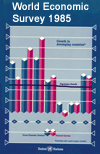
The crucial role of international trade in reinforcing global demand was evident in 1984, as the growth of world output gradually regained the pace of the late 1970s. Yet the geographical spread of the recovery remained limited, and economic growth in half of the developing countries was still so low that income per capita either continued to fall or stagnated. This uneven recovery, its sources and the policies conditioning its transmission, as well its short-term prospects, are the focus of World Economic Survey 1985.
1984
World Economic Survey 1984—Current Trends and Policies in the World Economy
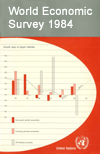
After the most protracted global economic recession since the 1930s, the prospects for sustained and broad-based growth are still not satisfactory. This unresolved issue is the focus of World Economic Survey 1984. A major development in 1983 was the recovery in North America. The recovery of the developed market economies as a whole is expected to become more widespread this year, but further strengthening beyond 1984 is uncertain.
Supplement to World Economic Survey 1984
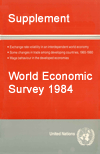
The Supplement to World Economic Survey 1984 comprises three studies: exchange rate volatility in an interdependent world economy; some changes in trade among developing countries, 1965-1980; and wage behaviour in the developed economies.
- Download full report:
- WES 1984,
- Supplement to WES 1984
1983
World Economic Survey 1983—Current Trends and Policies in the World Economy
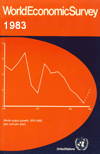
According to World Economic Survey 1983, the world economy remained in the grip of recession during 1982 and is only now beginning, in a few places, to show some signs of recovery. The unexpectedly severe contraction in demand that ensued from the anti-inflationary policies set in train by major industrial countries in 1979 and 1980 had brought about a sharp curtailment in the growth of world production and trade in 1981, and the deflationary impact of such policies was aggravated in 1982. In the developing countries as a group, output failed to increase for the first time in the post-war period.
Supplement to World Economic Survey 1983

The Supplement to World Economic Survey 1983 comprises three studies: recent experience in economic cooperation among developing countries and possibilities for progress in the 1980s; some effects of rising public expenditure in developed market economies; and the impact of workers' remittances on the balance of payments.
- Download full report:
- WES 1983,
- Supplement to WES 1983
1981–1982
World Economic Survey 1981–1982—Current Trends and Policies in the World Economy
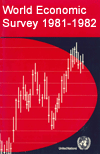
World Economic Survey 1981-1982 observes that economic expansion decelerated markedly throughout the world in 1981. The slowdown affected all major regions and groups of countries, independently of their level of development or economic structure. The deceleration was particularly intense in the developing countries, most of which experienced a significant fall in per capita income. The major factor behind the poor performance of the world economy was the recession in the Western industrial countries, where low growth caused a rise in unemployment, downward pressure on wages, and weakening primary commodity prices.
Supplement to World Economic Survey 1981–1982
The Supplement to World Economic Survey 1981-1982 comprises two studies: Some Notes on Recent Change in Commercial Policy of Developed Market Economies" and "Medium-term Growth and Trade in the Light of the Socio-economic Development Plans of Eastern Europe and the Union of Soviet Socialist Republics for 1981-1985".
- Download full report:
- WES 1981–1982,
- Supplement to WES 1981–1982
1980–1981
World Economic Survey 1980–1981
World Economic Survey 1980-1981 discusses the deterioration in the performance of the world economy in 1980, which was accompanied by a marked slowdown in the expansion of world trade, worsened imbalances in current accounts and an acceleration in the pace of inflation. Although some recovery in growth rates is anticipated beginning in late 1981, the pace is not expected to be vigorous. The poorer medium-term trend that has been in evidence since the mid-1970s is thus likely to continue.
1979–1980
World Economic Survey 1979–1980
World Economic Survey 1979-1980 observes that the present world economic situation is characterized by a slow pace of economic advance in most countries, which is expected to weaken further in the coming months, particularly in developed market economies. This is accompanied by high rates of price inflation (which are pervading all economies) and substantial changes in the pattern of current-account balances, occasioned principally by the doubling of the price of oil between the end of 1978 and the early months of 1980.
1978
World Economic Survey 1978
According to World Economic Survey 1978, the pace of world economic activity weakened in 1978. In developing countries, in particular, the trends towards lower rates of growth in output observed since 1975 were accentuated. The developed market economies continued to grapple with problems of insufficient recovery in productive investment. In the centrally planned economies, growth was restrained by external imbalances and international bottlenecks, especially in the energy and transport sectors.
Supplement to World Economic Survey 1978
The Supplement to World Economic Survey 1978 contains a study on "The Expansion of Exports from Developing Countries and Policies of Structural Adjustment in Developed Countries".
- Download full report:
- WES 1978,
- Supplement to WES 1978
1977
World Economic Survey 1977
World Economic Survey 1977 highlights a widespread uncertainty and unease about prospects for the world economy in 1978 and even over a longer time span. Although domestic income and output in 1977 and early 1978 have been continuing to increase in most countries, the pace has been moderating recently and shows no signs of quickening in the immediate future. For most countries—developing as well as developed—prospects are seen to depend quite heavily on events external to their domestic economy.
1976
World Economic Survey 1976
World Economic Survey 1976 reviews the main developments in the world economy in 1976 and the outlook for 1977. It summarizes the latest available data on world production and world trade and briefly examines the state of economic balance—internal, as revealed by changes in inflation and unemployment; and external, as revealed by changes in reserves, debt and exchange rates. As part of its overview of the world economy, the Survey also examines the most recent evidence of economic performance and problems in the developing countries.
Supplement to World Economic Survey 1976
While World Economic Survey 1976 presents a synoptic view of the world economy, with an emphasis on global aggregates, its Supplement looks behind these aggregates and examines in greater detail the events and policies in major regions and countries.
- Download full report:
- WES 1976,
- Supplement to WES 1976
1975
World Economic Survey 1975—Fluctuations and Development in the World Economy
World Economic Survey 1975 takes a closer look at the fluctuations and development in the world economy in the first half of the 1970s. The 1971-1975 period was one of great instability in which short-term problems and emergencies tended to pre-empt the attention of policymakers. The Survey also looks ahead to the second half of the decade and the efforts needed to restore more stable growth and improve the national and international division of labour and distribution.
Supplement to World Economic Survey 1975
The Supplement to World Economic Survey 1975 takes a closer look at the period that followed the adoption of the International Development Strategy for the Second United Nations Development Decade in October 1970. It analyses the ways in which individual countries and groups of countries reacted to the major global changes that shaped the world economy—the business cycle, the food crisis and the radical alteration in the energy situation.
- Download full report:
- WES 1975,
- Supplement to WES 1975
1974
World Economic Survey 1974
Part one: Mid-term Review and Appraisal of Progress in the implementation of the International Development Strategy
Part one of World Economic Survey 1974 was designed to assist in the second assessment of the way in which Governments are responding to the International Development Strategy for the Second United Nations Development Decade. It presents an overall analysis of economic and social performance in the developing countries and of the implementation of the Strategy by the developed market and the centrally planned economies.
Part two: Current Economic Developments
Part two of World Economic Survey 1974 analyses the salient features of world production and trade in 1974 compared with the earlier years of the Second United Nations Development Decade. It also deals in detail with the course of production and world trade, with problems of internal economic balance, including the acceleration of inflation in 1974 and the emergence of recessionary forces in the developed market economies. Finally, it examines the prospects for the world economy in 1975.
1973
World Economic Survey 1973
Part one: Population and Development
On the occasion of the World Population Year (1974), part one of World Economic Survey 1973 examines the recent interrelationships between demographic change and the process of socio-economic development.
Part two: Current Economic Developments
Part two of World Economic Survey 1973 presents and overview of world production and trade and analyses the three main features of the global economic scene in 1973—the rise in commodity prices, the world food situation and the world energy situation. It also examines the recent economic developments affecting the supply and use of resources and the state of internal and external balance in the world.
1972
World Economic Survey 1972—Current Economic Developments
World Economic Survey 1972 complements the documents prepared in connection with the biennial appraisal of progress under the International Development Strategy for the Second United Nations Decade. According to the Survey, an upsurge in production which got under way in the second half of 1971 has continued into the early months of 1973 and is projected to continue, at least for this year. Despite the breakdown of the international monetary system in August 1971 and the uncertainty that has prevailed ever since, international trade expanded with great vigour in 1972 and seems likely to continue on an upward trend in 1973. In a number of places, energy shortages have emerged, and in the face of the continuing high rate of increase in demand, there is now growing concern about an energy crisis. Meanwhile, both unemployment and price inflation rates remain above tolerable limits. The latter is generally recognized as a major structural problem among the developing countries.
1971
World Economic Survey 1972—Current Economic Developments
World Economic Survey 1971 examines some salient features of economic developments in 1970, taking into consideration the more detailed biennial report on the world economy that is to be issued in connection with the review and appraisal of the Second United Nations Development Decade. According to the Survey, 1971 witnessed a sluggish performance of the world economy in terms of both production and trade. The rate of growth of aggregate production of goods and services remained at about 4 per cent in 1971, not much more than that of the previous year. Although this rate fell short of the First United Nations Development Decade's annual average of 5.3 per cent, a worldwide recession, at times considered a possibility, was averted.
1969–1970
World Economic Survey 1969–1970
World Economic Survey 1969–1970 addresses the methodological problems that are involved in measuring progress in the developing countries. The Survey reviews the available data and suggests ways in which they might be used to throw light on the economic and social performance in the 1960s of the countries—both developing and economically more advanced—that will be implementing the International Development Strategy in the 1970s.
1968
World Economic Survey 1968
Part one: Some Issues of Development Policy in the Coming Decade
Part one of World Economic Survey 1968 discusses problems and policies relating to the prospective growth of population, employment and educational requirements. It also examines policies for the acceleration of agricultural and industrial growth in the coming decade, analysing the increase in domestic and external resources required for this acceleration and considering the implication for policies of both developing and developed countries.
Part two: Current Economic Developments
Part two of World Economic Survey 1968 reviews the recent trend in the world economy, analysing the developments in 1968 and offering an outlook for 1969 as it appeared in the middle of the year.
1967
World Economic Survey 1967
Part one: The Problems and Policies of Economic Development: An Appraisal of Recent Experience
Part one of World Economic Survey 1967 examines the principal features of economic progress of developing countries during the period 1955 to 1965. As part of the preparatory work for a second United Nations Development Decade, this review seeks to draw pertinent lessons from the recent experience relating to problems and policies of economic development.
Part two: Current Economic Developments
Part two of World Economic Survey 1967 highlights the main features of the world economic situation. The Survey covers the growth of output in 1967 and early 1968, and examines several topics of current concern in the field of international monetary and trade policy, including, inter alia, the devaluation of the pound sterling, reform of the international monetary system, implications of the Kennedy round and trends in regional integration. It further discusses changes in the methods of planning and management in the Union of Soviet Socialist Republics and Eastern Europe.
1966
World Economic Survey 1966
Part one: Implementation of Development Plans: Problems and Experience
Part one of World Economic Survey 1966 offers a series of papers dealing with problems and experience in the implementation of development plans. The subject of plan implementation has figured prominently in recent discussions in international forums. The Survey reviews certain aspects of the experience of the centrally planned economies that may be relevant to the problems of plan implementation in developing countries.
Part two: Current Economic Developments
Part two of World Economic Survey 1966 covers the economic events of 1966 and early 1967, summarizing the principal developments in the world economies, including trade and production in all major regions, as well as institutional changes in the centrally planned countries. Furthermore, the Survey analyses the specific difficulties currently faced by developing countries.
1965
World Economic Survey 1965
Part one: The Financing for Development
Part one of World Economic Survey 1965 deals with an issue that has been a matter of long-standing concern in various United Nations bodies, namely the financing of economic development. The Survey discusses the problem of increasing the volume of savings available to the developing countries, examining trends and sources of savings in the period 1953-1955 to 1962-1964. Finally, the Survey offers a perspective on economic development financing.
Part two: Current Economic Developments
Part two of World Economic Survey 1965 discusses the economic events of 1965 and early 1966, summarizing the principal developments in the world economies, including the major developments in the industrially advanced market economies that led to the adoption of disinflationary policy in some and deterioration in the external balance in others. The Survey also highlights the current developments in the centrally planned countries and reviews the new five-year plans of economic development.
1964
World Economic Survey 1964
Part one: Development Plans: Appraisal of Targets and Progress in Developing Countries
Part one of World Economic Survey 1964 reviews the experience gained and the techniques used by different countries in planning for economic development. It focuses attention on development plans in the developing countries. The Survey provides an overall view of the main characteristics of these plans; by tracing the interrelationships between the targets established in the plans, it brings out a number of important differences as well as certain similarities in the strategies proposed by various countries.
Part two: Current Economic Developments
According to part two of World Economic Survey 1964, the main challenges facing developed market economies are the use of incomes policies for internal stabilization and the difficulties facing the international monetary system in the light of the payments imbalances of the reserve currency countries. Meanwhile, a number of developing countries are struggling with the problem of agricultural lag and food supply and difficulties in maintaining internal balance. The Survey further highlights changes under way in the internal economic management of the centrally planned economies and the challenges of economic integration among the countries of the Council of Mutual Economic Assistance.
1963
World Economic Survey 1963
Part one: Trade and Development: Trends, Needs and Policies
Part one of World Economic Survey 1963 presents the second series of papers prepared for discussion at the second session (May–June 1963) of the Preparatory Committee for the United Nations Conference on Trade and Development, to be convened in 1964. These papers addressed the broad issue of trade as an instrument for economic development of the developing countries.
Part two: Current Economic Developments
Part two of World Economic Survey 1963 highlights the fairly vigorous pace of world economic growth in 1963 and early 1964, which has been more widespread among countries and more uniform among the major regions than in previous years. The primary producing countries as a whole benefited from the strengthening of world commodity markets and from better terms of trade. Part two contains an annex that summarizes the changes in the world primary commodity situation during the period 1962/63-1963/64.
Economic Developments in the Middle East 1961–63
As a continuation of the series of studies on the Middle East, this Supplement to World Economic Survey 1963 reviews economic developments in the Middle East from 1961 to 1963. During this period, the countries covered by this report experienced generally favourable developments, which, however, varied considerably from one country to another, and, within each country, from one economic sector to another. An improvement in weather conditions in the period covered was largely responsible for the substantial increases in the economic activities of the region as a whole.
- Download full report:
- Part I,
- Part II,
- Middle East 1961–1963
1962
World Economic Survey 1962
Part one: The Developing Countries in World Trade
Part one of World Economic Survey 1962 presents the first series of papers prepared for discussion at the second session (May-June 1963) of the Preparatory Committee for the United Nations Conference on Trade and Development, to be convened in 1964. These papers addressed the broad issue of trade as an instrument for economic development of the developing countries.
Part two: Current Economic Developments
According to part two of World Economic Survey 1962, the advances in production during 1962 were more moderate than in earlier years in many parts of the world, and frequently disappointed expectations. The rising trend in output, however, was well maintained in the early months of 1963, and the immediate outlook continued to be generally favourable. For the underdeveloped countries, the recovery from recession in North America, combined with some restocking in western Europe, favoured their export trade in 1962.
1961
World Economic Survey 1961
World Economic Survey 1961 focuses on industrialization and economic development, following the request by the Committee for Industrial Development for a review of industrialization in underdeveloped countries during the 1950s. The Survey also examines recent trends in the world economy, analysing the recent situation in the industrially advanced private enterprise economies. Special attention is paid to the recovery in North America and to the slackening of economic growth in western Europe and Japan.
Economic Developments in the Middle East 1959–1961
This study reviews current economic developments in the Middle East from 1959 to 1961. It starts out with a regional summary, with a view to bringing together and highlighting the important economic developments in the area in the period under discussion, and to pointing out the similarities and dissimilarities in individual countries. This is followed by a review of developments in the fields of agriculture, industry and mining, petroleum, and foreign trade and payments. The discussion in each chapter is developed so as to put the Middle East in perspective, without losing the identity of individual countries.
- Download full report:
- WES 1961,
- Middle East 1959–1961
1960
World Economic Survey 1960
Part one of World Economic Survey 1960 discusses the role of saving for economic growth in the world economies, as well as its sources and trends. Part two of the Survey covers the economic events of 1960 and early 1961, summarizing the principal developments in the world economies, including trade and production in all major regions, as well as institutional changes in the centrally planned economies.
1959
World Economic Survey 1959
World Economic Survey 1959 reviews the year, which witnessed new peaks in world production and incomes following the recovery from the 1957/1958 recession in the United States and the cessation of growth in 1958 in western Europe. The Survey also analyses the investment trends and policies in the 1950s and provides an economic outlook for 1960.
Economic Developments in the Middle East 1958–59
This study reviews current economic developments in the Middle East in the period from 1958 to 1959. Details of economic activity for each country—reflecting the variations in total, sectoral and per capita incomes—are fully treated in this study. The study also offers a set of statistical tables, appended to an introductory review of developments in agriculture, industrial production, petroleum, foreign trade and balance of payments.
1958
World Economic Survey 1958
In part one of World Economic Survey 1958, attention is focused on international commodity issues and policies in the post-war period. The Survey analyses trends and fluctuations in world trade of primary commodities, national and international commodity policies, and issues of primary commodities in the centrally planned economies. Part two of the Survey examines the recent events in the world economy, paying special attention to the recovery from recessionary trends, and provides an economic outlook for 1959.
Economic Developments in the Middle East 1957–1958
This study reviews current economic developments in the Middle East from 1957 to 1958. Details of economic activity for each country—reflecting the variations in total, sectoral and per capita income—are fully treated in this study. It notes, inter alia, that industrial output outside the oil sector made good progress during the period from 1957 to 1958. As in previous years, this was particularly the case for the electricity, construction and chemical industries.
- Download full report:
- WES 1958,
- Middle East 1957–58
1957
World Economic Survey 1957
World Economic Survey 1957 examines the problem of inflation, analysing its nature as well as recent governmental anti-inflationary policies, with particular emphasis on the role of monetary policies. Both demand and cost elements, as well as the significance of monetary factors are reviewed. The Survey also highlights recent events in the world economy, paying special attention to the factors underlying the recessionary trends that emerged in 1957, and provides an economic outlook for 1958.
Economic Developments in the Middle East 1956–1957
This study reviews current economic developments in the Middle East from 1956 to 1957. Details of economic activity for each country—reflecting the variations in total, sectoral and per capita incomes—are fully treated in this study. In line with the examination of inflation presented in World Economic Survey 1957, this study focuses on the economic forces which have given risen to inflationary or disinflationary pressures in the Middle East over the past few years.
Economic Developments in Africa 1956–57
This study examines the repercussions of changes in commodity markets on the economies of tropical African countries. The gradual weakening of primary commodity prices that has been noticeable since 1954 continued into the early months of 1956. While not all primary commodities showed the same downward trend in 1957, the terms of exchange between primary commodities and manufactured goods became progressively less favourable for primary producers, owing to the continuing rise of the price index of manufactures in international trade.
- Download full report:
- WES 1957,
- Middle East 1956–1957,
- Africa 1956–1957
1956
World Economic Survey 1956
World Economic Survey 1956 is devoted to a study of balance of payments problems during the post-war period. It reviews the worldwide balance-of-payments experience since the war, the changes in the network of international balances and the pattern of international settlements. Furthermore, the post-war forces shaping the balance of payments of the primary producing countries are studied. The Survey also analyses recent events in the world economy, giving special attention to the factors underlying economic expansion in 1956 and the role of policy in promoting stability and growth. Finally, it provides an economic outlook for 1957.
Economic Developments in the Middle East 1955–1956
This study reviews current economic developments in the Middle East from 1955 to 1956. During 1955 and until October 1956, the main factors affecting the level of economic activity in the Middle-East originated within the region itself. Demand for the region's exports maintained its upward trend; most of this increase was accounted for by petroleum, but other products, notably cotton, also shared in the rise. Also, during the period under review, most countries experienced inflationary pressures.
Economic Developments in Africa 1955–56
This study considers some significant aspects of economic development during 1955 and 1956 in selected African countries. In the Union of South Africa, the rate of expansion in national income slowed down appreciably. In northern Africa, there was a decline in the physical volume of production. The most significant developments in the money economies of tropical Africa were the consequences of changes in world prices of primary commodities.
- Download full report:
- WES 1956,
- Middle East 1955–1956,
- Africa 1955–1956
1955
World Economic Survey 1955
World Economic Survey 1955 reviews the growth of production and trade in private enterprise economies and the centrally planned economies during the first post-war decade. The introduction examines some of the major problems of balanced growth encountered since the war. The Survey also highlights recent developments in the world economy, covering the recent situation in industrially advanced and primary producing private enterprise economies, as well as in the centrally planned economies. The Survey briefly assesses the economic outlook at the beginning of 1956.
Economic Developments in the Middle East 1954–1955
This study presents a synoptic view of the main economic developments in the Middle East during 1954 and 1955. It analyses the main factors affecting the level of economic activity. In the study's introduction, the topics of population, income and economic development in the Middle East as a whole are discussed.
Economic Developments in Africa 1954–55
This study considers some significant aspects of economic development during 1955 and 1956 in selected African countries. In the Union of South Africa, the general increase in economic activity has been accompanied by inflationary pressure. In order to counter such pressures, interest rates were raised. In northern Africa, a difficult situation was aggravated by internal strife which adversely affected production and investment. In tropical African countries, export earnings, the main source of money income, continued to expand in 1954 with a 10 per cent rise from the previous years.
- Download full report:
- WES 1955,
- Middle East 1954–1955,
- Africa 1954–1955
1953–1954
World Economic Report 1953–54
World Economic Report 1953-54 analyses recent major changes in domestic economic conditions and in international trade and payments, with special emphasis on developments in 1953 and 1954. The Report reviews the economic developments in three broad groups of countries: economically developed private enterprise economies, centrally planned economies and economically underdeveloped private enterprise economies.
Review of Economic Activity in Africa 1950–1954
In the five years reviewed in this study (1950-1954), most parts of Africa experienced an increase in the level of economic activity. The total value of exports, the main source of money income in Africa, increased considerably. At the same time, expenditure on post-war development plans has been at a high level. These development expenditures have been financed in part—largely in French territories—by funds from external sources and have thus been additional to export earnings. There has also been considerable public foreign investment, particularly in central and southern Africa.
- Download full report:
- WER 1953–54,
- Africa 1950–1954
1952–1953
World Economic Report 1952–1953
World Economic Report 1952-53 analyses major changes in domestic economic conditions and international trade and payments from 1950 to 1953, with special emphasis on developments in 1952 and 1953. The introduction surveys current economic problems in the light of economic developments since the Second World War. The Report also highlights changes in international trade and payments and in the external transactions of countries which, for the most part, are exporters of manufactured products or of primary commodities, as well as of countries with centrally planned economies.
Summary of Recent Economic Developments
in the Middle East 1952–1953
This Summary analyses the main economic developments in the Middle East during 1952 and 1953. The introduction presents an overall view of the main economic trends in the region, where, during that period, deflationary tendencies of varying degrees of intensity appeared in a number of countries. Two chapters are devoted to major aspects of production and trade of petroleum. The Summary also contains three studies of individual countries: Egypt, Israel and Turkey.
- Download full report:
- WER 1952-1953,
- Africa 1952-1953,
- Middle East 1952-1953
1951–1952
World Economic Report 1951–1952
World Economic Report 1951-52 highlights the major domestic economic changes in economically developed private enterprise economies, centrally planned economies and selected countries of Latin America and the Far East. The Report also studies the changes in international trade and payments in several major economic powers. From 1950 to 1952, these took place in a context of continuing international disequilibrium.
Review of Economic Conditions in the Middle East 1951–1952
This Review analyses the main factors affecting the level of economic activity in the Middle East during 1951 and 1952: agriculture, industry and petroleum. The introduction discusses the problems of production and prospects for economic development. The Review also assembles information on the aid given to Palestine refugees by the United Nations and on the contribution made to the economic development of the region during recent years by international organizations and foreign countries, in the form of both capital and technical assistance.
- Download full report:
- WER 1951–52,
- Middle East 1951–1952
1950–1951
World Economic Report 1950–1951
World Economic Report 1951-52 highlights the major domestic economic changes in economically developed private enterprise economies, centrally planned economies and selected countries of Latin America and the Far East. The Report also studies the changes in international trade and payments in several major economic powers. From 1950 to 1952, these took place in a context of continuing international disequilibrium.
Summary of Recent Economic Developments
in the Middle East 1950–1951
This Review analyses the main factors affecting the level of economic activity in the Middle East during 1951 and 1952: agriculture, industry and petroleum. The introduction discusses the problems of production and prospects for economic development. The Review also assembles information on the aid given to Palestine refugees by the United Nations and on the contribution made to the economic development of the region during recent years by international organizations and foreign countries, in the form of both capital and technical assistance.
- Download full report:
- WER 1950–51,
- Africa 1950-1951,
- Middle East 1950–1951,
- Suppliment 1950–1951
1949–1950
World Economic Report 1949–1950
World Economic Report 1949-50 analyses major developments in domestic economic conditions and international economic relations during 1949 and the first half of 1950, with some preliminary comments on tendencies since mid-1950. The Report also presents a discussion of two special problems: the factors underlying the persistent dollar deficits in a large part of the world prior to 1949 and the relationship between the currency devaluation of 1949 and subsequent developments in international trade.
- Download full report:
- WER 1949-1950,
- Africa 1949–1950,
- Middle East 1949–1950
1948
World Economic Report 1948
World Economic Report 1948 assembles a considerable volume of post-war economic data relating to all regions of the world not hitherto available within the compass of a single study. The Report aims to provide a comprehensive survey of the world economic situation in 1948, and to indicate major economic problems and prospects as at the end of the year. In addition, present economic conditions in various areas of the world are compared with those which prevailed before the war. Particular attention is drawn to certain significant economic trends during 1948 and the early months of 1949 which appear to call for national and international action.
Major Economic Changes in 1948
Part one of Major Economic Changes in 1948 provides a broad picture of the main economic developments during the year. It also focuses on the world supply of commodities, inflationary and deflationary developments in 1948, and international trade and finance. Part two of this study analyses selected world economic indices such as general trends in industrial production, food production, fuel and energy output, production of raw materials, and manufacturing activities in selected industries.
Supplement to Major Economic Changes in 1948
This Supplement to Major Economic Changes in 1948 presents a verbatim record of the discussion of the world economic situation in the Economic and Social Council at its eighth session, which took place from 21 to 25 February 1949. At the conclusion of its discussion, the Council adopted a resolution drawing the attention of Member Governments of the United Nations, the Economic and Employment Commission, the regional economic commissions and the specialized agencies to the views expressed by members of the Council.
1947
Salient Features of the World Economic Situation 1945-47
Salient Features of the World Economic Situation 1945-47 is the first economic report in a planned series designed to meet the need—recognized by the General Assembly and the Economic and Social Council—for a regular appraisal of world economic conditions and trends as a prerequisite for recommendations as to concerted national or international action in the economic field.